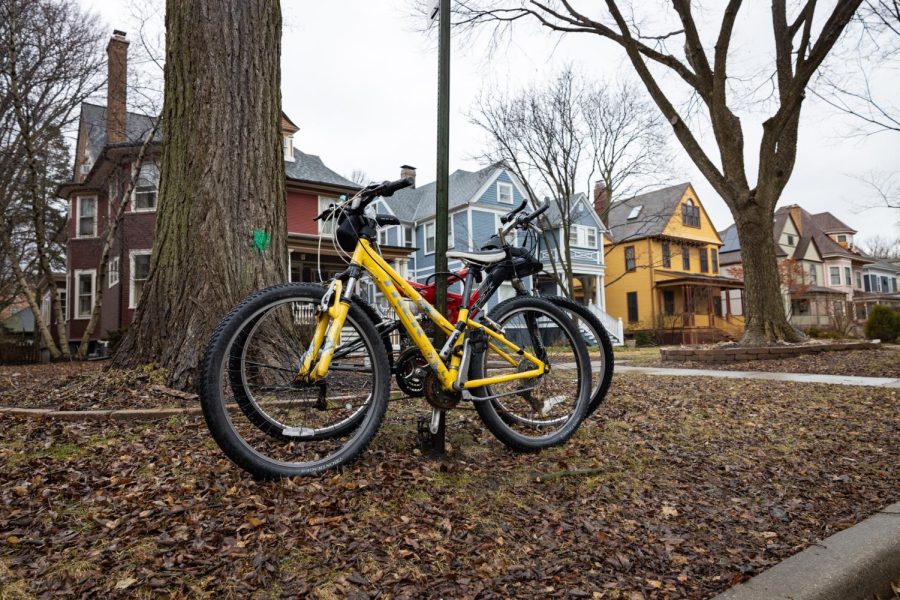Proposed bike trail brings promise, peril to the 5th ward
Joanne Haner/Daily Senior Staffer
Evanston is working to increase biking access to underserved neighborhoods.
January 17, 2023
Ald. Bobby Burns (5th) remembers making the journey many times when he was young. It started with sneaking through the Canal Shores Golf Course and venturing down a back alley before dodging the cars screaming down Green Bay Road.
Burns, who grew up in the 7th ward, would often make this trip to visit friends in the 5th. The simplest route would be through the intersection of McCormick Boulevard and Green Bay Road — but that’s where the Metratracks rise some 15 feet above the sidewalks, making crossing all but impossible.
“The train tracks kind of split the two wards,” Burns said. “There’s a way to get through, but it’s not an easy one.”
However, this may soon change with a plan to build a tunnel under that intersection. The Evanston Transit Alliance proposed a bike trail that would connect the North Shore Channel Trail to other trails north of Evanston. The proposal places the 5th ward at the center of a biking corridor stretching from northern Chicago to southern Wisconsin, punching a hole through those impermeable tracks.
The intersection is also emblematic of Evanston’s history of redlining, when the city used the North Shore Channel and the train tracks to physically restrict movement between the historically Black 5th ward and whiter wards. Through this lens, arduous journeys like Burns’ seem less like the exception and more like the remnants of a racist past.
That blockade still affects the 5th ward, according to Burns. The lack of connectivity to Evanston has stunted economic growth in the neighborhood.
“The 5th ward has struggled with foot traffic,” he said. “The more we can incentivize people to come, it will help the storefront businesses.”
Restoring this connectivity is part of the ethos behind the North Channel Trail extension, said Evanston Transit Alliance member John Fervoy, who is spearheading the project.
It is also part of a larger movement in transportation planning that seeks to address racist decisions made during the 20th century, according to Tim Gustafson, a planner engineering the trail extension.
“Because those decisions were made, and they had such a profound impact on changing and shaping communities, we know the transformative potential that stitching them back together can bring,” he said.
Though, Fervoy and Gustafson say that the project isn’t without risk. In 2015, a bike path along old train tracks brought new pedestrian traffic to transportation-starved Logan Square.

With it came businesses and more economic activity — but in 2018, those developments brought the largest property-tax increase anywhere in Chicago, forcing many low-income residents out. Now, Chicago leaders are scrambling to stop developers from demolishing affordable housing and displacing residents.
Fifth ward residents worry that their neighborhood has a similar fate.
“I’ve seen the changes,” said Bob Pascoe, pointing to a brand-new microbrewery that stands out against the 5th ward’s industrial buildings. “It’s starting to look like downtown Evanston.”
Pascoe, who owns R&S Auto, said he’s worried that new businesses will push out community-based ones like his and that current residents, facing higher taxes and rent, will leave with them.
He said 5th ward residents would appreciate expanded biking access, including every biker friend of his, whom he listed until he ran out of fingers to count them. However, he says he doesn’t think they’ll be able to stay long enough to enjoy the trail’s benefits.
“Most of the people who would benefit are the rich people who live in Wilmette,” Pascoe said.
Gustafson said he is empathetic to these concerns. He used to live in the gentrifying Andersonville neighborhood under a landlord who kept rents affordable. But when the landlord retired and sold the building to developers, they didn’t renew his lease, forcing Gustafson to relocate to Rogers Park.
There, he was able to put a down payment on a condominium, establishing a foothold that would prevent a similar experience in the future. He said that this is a privilege not everyone has and that the government could help lower-income people establish such roots. Gustafson pointed to Belmont Cragin, a neighborhood just a few miles away from Logan Square, as an example. There, land-use investments — subsidizing businesses and housing — preceded transportation increases, helping the neighborhood develop with less displacement.
Higher density and increased property ownership amongst residents could help ease the burden of development. However, with the trail extension still years away, Burns said he hasn’t explored pairing specific land-use improvements with transportation ones in the 5th ward.
But for bike advocates and community members alike, it’s never too early to be proactive.
“Why not give money to the poor people first, then build it?” Pascoe said.
Email: [email protected]
Twitter: @charcole27
Related Stories:
— Chicago-area biking groups push for bike trail upgrades, sustainable infrastructure
— City Council discusses need for community feedback on 5th Ward school plans


